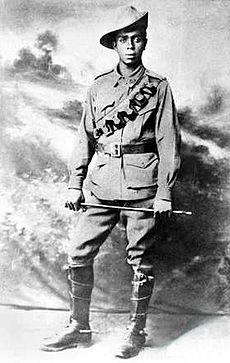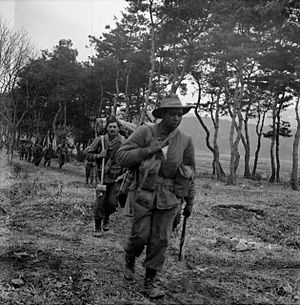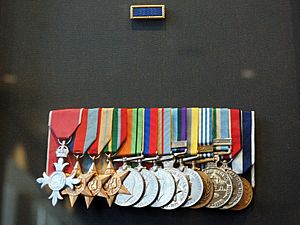Reg Saunders facts for kids
Quick facts for kids
Reg Saunders
|
|
|---|---|
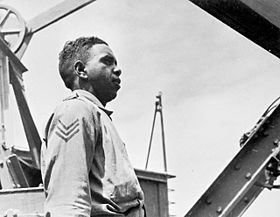
Reg Saunders in 1940
|
|
| Birth name | Reginald Walter Saunders |
| Born | 7 August 1920 Framlingham, Victoria |
| Died | 2 March 1990 (aged 69) Sydney, New South Wales |
| Allegiance | Australia |
| Service/ |
Australian Army |
| Years of service | 1940–45 1950–54 |
| Rank | Captain |
| Unit | 2/7th Battalion (1940–45) 3 RAR (1950–51) |
| Battles/wars | Second World War
Korean War
|
| Awards | Member of the Order of the British Empire |
| Other work | Department of Aboriginal Affairs |
Reginald Walter Saunders, known as Reg, was a brave Aboriginal Australian soldier. He made history as the first Aboriginal person to become an officer in the Australian Army.
Reg came from a family with a strong military background. His relatives had fought in earlier wars, like the Boer War and the First World War. Reg joined the army in 1940, ready to serve his country.
During the Second World War, he fought in North Africa, Greece, and Crete. He showed great leadership and was promoted to lieutenant. He then led a group of soldiers in New Guinea from 1944 to 1945. Sadly, his younger brother, Harry, also joined the Army and died in 1942 during the Kokoda Track campaign.
After the war, Reg returned to civilian life. But he wasn't done serving. He later became a company commander with the 3rd Battalion, Royal Australian Regiment (3 RAR) during the Korean War. He fought bravely in important battles like the Battle of Kapyong.
Reg left the Army in 1954. He worked in different jobs before joining the Office of Aboriginal Affairs in 1969. This office later became the Department of Aboriginal Affairs. In 1971, he was honored with the Member of the Order of the British Empire (MBE) award for his important work helping his community. Reg Saunders passed away in 1990 at the age of 69.
Contents
Early Life and Family
Reg Saunders was born on August 7, 1920. His birthplace was near Purnim, on the Aboriginal Reserve at Framlingham in western Victoria. He was a proud member of the Gunditjmara people.
His father, Chris, was a veteran of the First World War. He had served as a machine gunner. One of Reg's uncles, William Reginald Rawlings, was killed in action during that war. Reg was named after him. This uncle had received the Military Medal for his bravery in France. Another ancestor, John Brook, fought in the Boer War.
Reg's mother died in 1924 while giving birth to her third child, who also passed away. After this, his father moved to Lake Condah with Reg and his younger brother, Harry, who was born in 1922. Their father worked many jobs, so the boys were mostly raised by their grandmother.
Reg went to the local mission school at Lake Condah. He was good at maths, geometry, and languages. His father also taught Reg and Harry about the Australian bush. He encouraged them to read classic books. After eight years of school, Reg earned his merit certificate.
At 14, Reg started working at a sawmill. Employers sometimes didn't pay Aboriginal workers fairly back then. But Reg insisted on getting his full pay, and his employer agreed. He kept working and learning until 1937. Then, he started a sawmill business with his father and brother in Portland. Sadly, a bushfire destroyed their sawmill in 1939.
Serving in the Second World War
When the Second World War began, Reg Saunders was determined to join the army. He felt patriotic and wanted to follow his family's soldiering tradition. His father suggested he wait six months. Reg recalled, "They were talking about this war being all over in six months... But we waited six months and the duck season was over so there was no more shooting to do except go to war."
Reg joined the Second Australian Imperial Force on April 24, 1940. He joined with friends he knew from playing Australian rules football. At that time, the army did not stop Aboriginal people from joining. Reg remembered that his fellow soldiers "were not colour-conscious." During training, his white friends would sit with him in the "Aboriginal" section of movie theaters.
Reg's natural leadership skills quickly earned him promotions. Within six weeks, he was a lance corporal. After three months, he became a sergeant.
Battles in North Africa, Greece, and Crete
After training, Reg joined the 2/7th Battalion. This infantry unit was serving overseas in North Africa. When he arrived, Reg went back to being a private. His first experience of war was fighting the Italians near Benghazi.
In April 1941, Reg's unit was sent to Greece. They were there to help defend against a German invasion. After many difficult fights, the battalion was evacuated on April 26. They boarded a ship called the Costa Rica at Kalamata. The ship was attacked by German planes and began to sink. Reg and the other men were rescued by British destroyers and taken to the island of Crete. The 2/7th Battalion then became part of the island's defense.
The invasion of Crete happened in May 1941. Reg's battalion first defended the coast. Then, they fought near Canea. They also took part in a fierce bayonet charge at 42nd Street with the New Zealand Maori Battalion. This charge killed almost 300 Germans and slowed their advance. During this battle, Reg killed his first enemy soldier. He remembered it felt "just like shooting a kangaroo... just as remote."
As the Allies started to leave Crete, the 2/7th Battalion stayed behind to protect the other units. After the last Allied ships left on June 1, 1941, many soldiers were captured. However, some, including Reg, managed to hide in the hills and caves. Reg dressed like a Cretan, learned their language, and got help from local people. He stayed hidden for eleven months.
Becoming an Officer
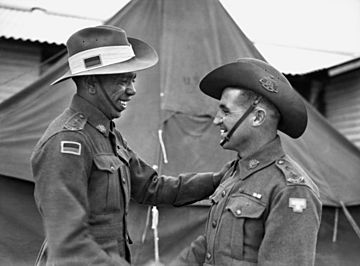
In May 1942, a British submarine rescued Reg from Crete. He returned to Australia in October. He rejoined his old unit, the 2/7th Battalion. They had reformed and returned to Australia to help defend against Japan.
In November 1942, Reg's younger brother, Harry, was killed in action in New Guinea. Harry was serving with the 2/14th Battalion. Reg had been angry when Harry joined because he wanted to be the only one fighting. He thought, "with two of us there, one of us was going to get killed."
Reg later served in New Guinea himself. He fought in the Salamaua–Lae campaign in mid-1943. He was promoted to temporary sergeant again. When his platoon commander was wounded, Reg took command. His commanding officer, Lieutenant Colonel Henry Guinn, recommended him to become an officer. Reg laughed and said he didn't want to be an officer. But Guinn insisted.
Reg went before an officer selection board in Queensland. The board decided he was a good candidate. He was sent to an officer training unit in Seymour, Victoria. After a 16-week course, he was promoted to lieutenant in November 1944. This made him the first Aboriginal commissioned officer in the Australian Army.
His promotion was a big deal. The Army was careful because of its "special significance." The paperwork went all the way to the Commander-in-Chief, General Sir Thomas Blamey, for approval. Blamey believed that Reg's commission should be treated like any other soldier's. The news was widely reported in Australia, mostly in a positive way.
After his promotion, Reg returned to New Guinea. He rejoined his old battalion, even though it was against policy. He commanded a platoon during the Aitape–Wewak campaign until the war ended. Reg was wounded in the knee by Japanese gunfire near Maprik and spent three weeks in the hospital.
Between Wars and the Korean War
Reg Saunders left the Army on October 5, 1945, after the Second World War ended. He wanted to serve in Japan, but the government would not accept Aboriginal people for that mission. Reg spoke out against this policy, calling it "narrow-minded and ignorant." The rule against non-European enlistments was not lifted until 1949.
Reg moved to Melbourne with his family. He had married Dorothy in 1944, and they had three young children. Dorothy had served in the Women's Auxiliary Australian Air Force during the war. Reg found civilian life difficult after the war. He faced discrimination that he rarely saw as a soldier. He worked as a tram conductor, a foundry worker, and a shipping clerk.
Service in the Korean War
In August 1950, the government asked Second World War veterans to serve in the Korean War. Reg volunteered and returned to the Army as a lieutenant. After training, he arrived in Korea in November 1950. He served with the 3rd Battalion, Royal Australian Regiment (3 RAR).
In February 1951, Reg took charge of A Company when its commander was wounded. He was later given command of C Company. Promoted to captain, Reg led C Company during the Battle of Kapyong in April. In this battle, 3 RAR and a Canadian battalion bravely held off a Chinese division. Reg felt proud after Kapyong, saying, "At last I felt like an Anzac." The 3rd Battalion received a US Presidential Unit Citation for their actions. Reg was recommended for an award but turned it down.
In October, he led a machine gun platoon at the Battle of Maryang San. He reportedly shared a moment with another officer. Looking at the tough mountain, his friend said, "No country for white men." Reg replied, "It's no country for black men, either." He returned to Australia in November 1951.
Later Life and Community Work
In 1953, the Returned and Services League of Australia (RSL), a veterans' group, suggested Reg be part of the Australian group for the coronation of Elizabeth II. However, the government said no, because it would mean removing an officer already chosen.
After the Korean War, Reg stayed in the Army, overseeing training for national servicemen. But he soon became unhappy without active service. In 1954, he left the Army. That same year, he married Pat Montgomery, an Irish nurse. His first marriage had ended after he returned from Korea.
Reg worked in the logging industry in Gippsland. Then he moved to Sydney and worked for a metal company. Many people saw Reg as a role model for Aboriginal Australians. In 1969, he started working for the Office of Aboriginal Affairs. He was one of its first liaison officers. His job was to share information about new government funding for Aboriginal and Torres Strait Islander businesses and schools. He also connected with Aboriginal welfare groups. He said, "I felt a sense of leadership of Aboriginal people and a desire to do something about the Aboriginal situation."
His community work was recognized in June 1971. He was appointed a Member of the Order of the British Empire (MBE) in the Civil Division. In 1972, he wrote an article in Identity magazine, encouraging Aboriginal people to vote.
Reg continued to work with the Department of Aboriginal Affairs in Canberra until he retired in 1980. In July 1985, he joined the Council of the Australian War Memorial. He held this position until his retirement. He was also involved with the RSL. However, he disagreed with some leaders who suggested blood-testing Aboriginal people for government benefits. Reg said, "They can take all the blood they want from me... and they'll never find out what I am – least of all an Aborigine – bloody stupid!"
Reg Saunders had ten children from his two marriages, both of which ended in divorce. Two of his children passed away before him. Reg had heart problems and died on March 2, 1990. His ashes were scattered on Lake Condah, the traditional land of the Gunditjmara people. One of his sons followed him into the Army, and four of his daughters married soldiers. His son Christopher played him in a 1978 TV show called The Sullivans.
Memorials and Legacy
On December 14, 2001, Reg Saunders was honored with a street named after him. Reg Saunders Way passes through Canberra. The Secretary of the Department of Defence and the Chief of the Defence Force attended the ceremony. A room in the Canberra Services Club is also named after him. The RSL offers a Captain Reg Saunders Scholarship.
The Australian War Memorial has Reg Saunders' medals and personal items in its national collection. They also have an official portrait and photographs of him. On November 11, 2015, the Australian War Memorial's Western Gallery and Courtyard were renamed in his honor. These were the first parts of the Memorial to be named after an Australian.


